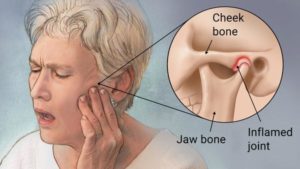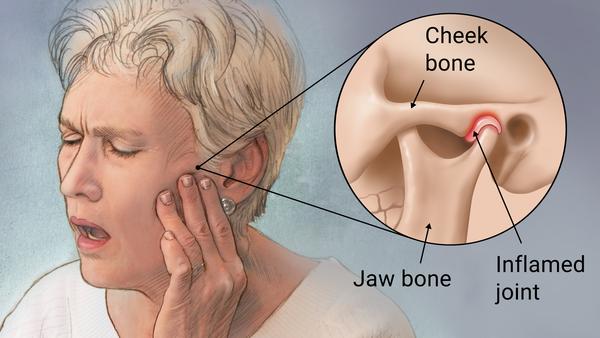Temporomandibular Joint Disorder
 The temporomandibular joint (TMJ) is a hinge-like connection point between your jaw and skull. It is what allows us to move our jaw when we eat or talk. Several factors can cause this joint to become irritated or inflamed leading to a painful condition called temporomandibular joint disorder, or TMD.
The temporomandibular joint (TMJ) is a hinge-like connection point between your jaw and skull. It is what allows us to move our jaw when we eat or talk. Several factors can cause this joint to become irritated or inflamed leading to a painful condition called temporomandibular joint disorder, or TMD.
What are the Symptoms of TMD?
The TMJ is a complex system, controlled by muscles of the face. Therefore, when the joint becomes inflamed in TMD, muscles around it can tense, leading to facial pain. This can include:
- Frequent headaches
- Pain when swallowing, eating, talking, or yawning
- Clicking when opening the mouth
- Earaches
- Limited mouth opening
What Causes TMD?
Due to the complex nature of the TMJ, there are several different possible causes of TMD. Most often, the inflammation comes from overuse of the joint or misalignment between the upper and lower jaw. The most common causes of TMD are:
- Clenching or grinding
- Poor alignment of teeth
- Bad posture
- Stress and anxiety
- Frequent gum chewing
- Extensive orthodontic treatment
How do you Treat TMD?
TMD is a very common condition and there are many treatments available to ease the symptoms. Some of the treatments include:
- Special retainer (nightguard) to help relax the jaw or keep teeth slightly separated at night, called a bite plane
- Reducing stress and anxiety
- Learning to avoid clenching or grinding the teeth
- Fixing potential alignment issues between the upper and lower jaw
- Limiting hard food diets
It is important to first determine the cause of TMD before looking into treatment options. Consult with your dentist if you have any of the symptoms of TMD to see what can be done for you.
References:
Temporomandibular Disorder (TMD). (n.d.). Retrieved from https://www.hopkinsmedicine.org/health/conditions-and-diseases/temporomandibular-disorder-tmd
Justin L. Kaplan MD, Robert S. Porter MD, eds. 2018. Merck Manual Professional Version. Whitehouse Station, NJ. Merck Sharp & Dohme Corp., A Subsidiary of Merck & Co., Inc. STAT!Ref Online Electronic Medical Library. http://online.statref.com.ezproxy.library.tufts.edu/Document.aspx?docAddress=trs16m1005e9oBMiRczm6A!!. 8/4/2019
TMJ disorders. (2018, December 28). Retrieved from https://www.mayoclinic.org/diseases-conditions/tmj/symptoms-causes/syc-20350941?utm_source=Google&utm_medium=abstract&utm_content=Temporomandibular-joint-dysfunction&utm_campaign=Knowledge-panel

